Polymer science is a very active and competitive area of chemical research, which has inevitably resulted in the generation of a large volume of intellectual property, particularly patents. However, the large number of patent filings and the competitiveness in the field has also fuelled a culture of competitors challenging those patents.
A granted European patent can be challenged centrally at the EPO by filing an opposition. Oppositions can be filed by any third party within nine months of the grant date, and the outcome of the opposition procedure is effective across all of the designated states. For any third party worried that a recently granted patent may restrict their commercial operations, oppositions provide an excellent tool of attacking the patent, either to try to narrow the scope of the claims, or to get the patent revoked in its entirety. Oppositions tend to incur very modest costs compared to litigation before a national court, especially given litigation actions may need to be instigated in multiple countries.
For the patentee, the opposition period therefore represents a vulnerable time where the patent that they have worked so hard to get through to grant is open to further attack.
Likelihood of an opposition
Polymer science is a technical area in which a large number of oppositions are filed. Data released by the EPO last year1, covering opposition statistics from 2020, supports this by suggesting that comparatively more patents were opposed in 2020 in the field of polymers (5.0%) compared to chemistry overall (4.7%) or the EPO average (2.4%). This is demonstrated graphically in Figure 1 below:
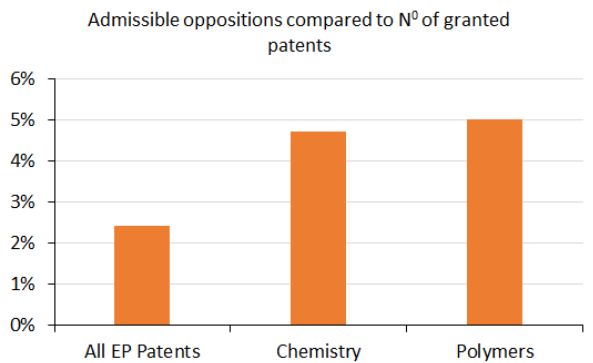
Figure 1 - Opposition rate in 2020. Data taken from EPO statistics 2020 report1. Rate is based on the number of opposed patents in 2020 compared to the number which could have been opposed.
Is this opposition rate something to be worried about?
A large number of oppositions does not necessarily result in a large number of revoked patents; it could merely suggest a large number of unsupported and ineffective oppositions. However, the EPO's data from 20201, shows the revocation rate for oppositions against polymer patents decided within 2020 was 39%, compared to 37% for chemistry overall and 35% as the EPO average.
To confirm this statistic, we conducted a search of all opposition outcomes since 2010 within IPC classification C08* (polymers) using a specialist IP database.2 The results shown in Figure 2 are in agreement with the data from the EPO report and show that a patent proprietor in the polymer field is significantly more likely to have their patent either revoked entirely or maintained in an amended form, than to retain their claims as granted.
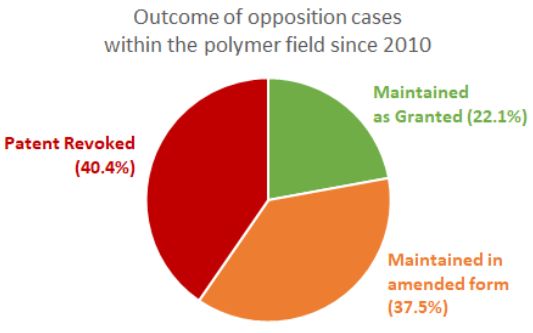
Figure 2 - Outcome of oppositions in the polymer field* since 2010. Data obtained from ipQuants.2
As a result, there appears to be both a high opposition rate and a high chance of a negative opposition outcome for a patentee working in the polymer field.
Appeals - do they help the patentee?
After an opposition decision issues, any negatively affected party is entitled to file an appeal against that decision. An appeal filed by the patentee may therefore provide a chance of saving a patent, whereas an appeal filed by the opponent can be a further attempt at revocation of the patent or limitation of claim scope. Figure 3 shows the outcome of any of those opposition cases depicted in Figure 2 that involved a subsequent appeal stage.
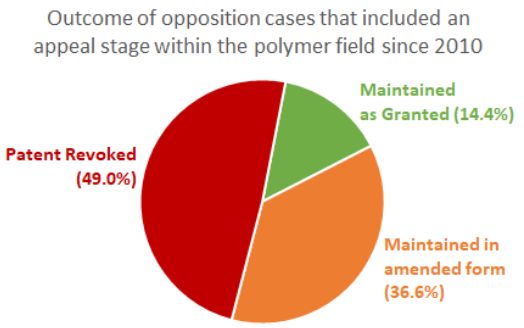
Figure 3 - Overall outcome of opposition cases that included an appeal stage within the polymer field* since 2010. Data obtained from ipQuants.2
Figure 3 suggests that the inclusion of an appeal stage generally results in an increase in the number of patents being revoked (i.e. success for the opponent). Only 14% of the patents which were opposed and subsequently appealed were maintained with their claims as granted. Oppositions therefore present a very powerful tool against polymer patents and it is imperative for patentees to understand the issues that are commonly raised in these oppositions and how they can be avoided.
What issues do polymer patents face during opposition?
To understand what is causing the increased revocation rate, and what a patent proprietor needs to consider in order to strengthen their position, we used another specialist IP database3 to gain insights on particular points of law. Specifically, we researched how often a decision on a certain point of law has been made between 2010 and 2022 and the specific outcome of that decision. Figure 4 below shows these results for the main grounds of opposition, comparing all EPO cases with cases having the IPC classification C08* (polymers).
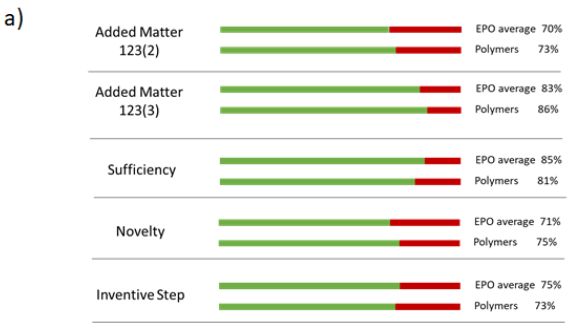
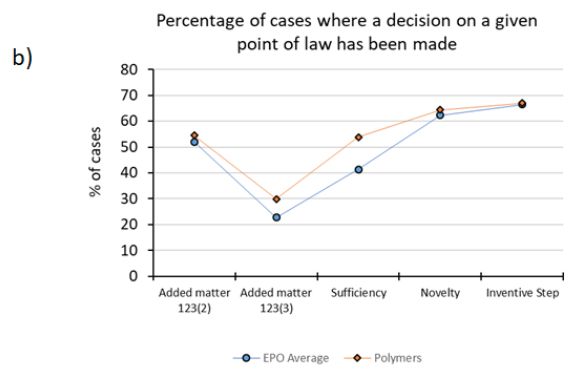
Figure 4 -a) Outcome of decisions on various points of law between 1 January 2010 and 1 January 2022, where the green bars represent a successful defence by the patentee in this area and the red bars indicate a successful challenge by the opponent. b) Frequency of decisions on various points of law between 1 January 2010 and 1 January 2022. Data obtained from searches conducted using Darts-ip.3
In general, the data shows that when a decision by the Opposition Division is made on a given point of law, polymer patentees have a similar chance of successfully defending their claims compared to the EPO average (see the green bars in Figure 4a). The grounds on which a Patentee seems to have a slightly lower chance than the EPO average are sufficiency and inventive step.
However, Figure 4b shows that certain grounds (i.e. added matter, sufficiency) are discussed more often in polymer cases compared to the EPO average, while others (e.g. inventive step) remain at a similar level. This suggests that opponents raise an increased number of substantial attacks against polymer patents, leading to more points to be discussed by the Opposition Division. The increased number of attacks the patentee has to defend could be the cause of the increased likelihood of revocation or limitation.
The increase in the number of attacks is also seen in less frequently raised points of law, for example product by process issues and selection inventions. This is shown in figure 5 below.
|
Other points of Law |
No. decisions compared to No. of oppositions |
|
|
All IPC |
C08 |
|
|
Product by Process claims |
0.66% |
1.76% |
|
Selection inventions |
3.27% |
8.36% |
Figure 5 - Frequency of certain points of law being discussed in opposition decisions between 1 January 2012 and 1 January 2022.
While this increase in the number of attacks appears challenging for the patentee, issues concerning added matter, sufficiency, product by process claims and selection inventions can often be avoided through diligent drafting and prosecution practices, especially if the patentee knows that they need to take extra consideration in these areas.
Summary
Overall, polymer patents appear to be more likely to be opposed to patents in other technical areas and to suffer from an increased likelihood of a negative outcome for the patentee. It appears that the latter may be caused by an increase in the number of attacks being raised by opponents in certain areas, including added matter and sufficiency. While this may, in part, be due to limitations in how inventions can be described within the technical field, we believe many of these issues are avoidable through careful drafting and prosecution. In subsequent articles we will look into some of the potential pitfalls and provide input on how they can potentially be overcome.
*any patent classified under the C08 IPC code. This code covers organic macromolecular compounds, their compositions and preparation.
Footnotes
1 = Annual compendium of statistics on the activity at the EPO and at the member state offices in 2020 (https://www.epo.org/modules/epoweb/acdocument/epoweb2/521/en/CA-F_5-21_en.pdf)
2 - ipQuants AG www.ipQuants.com
3 - Darts-ip https://clarivate.com/darts-ip/
The content of this article is intended to provide a general guide to the subject matter. Specialist advice should be sought about your specific circumstances.


